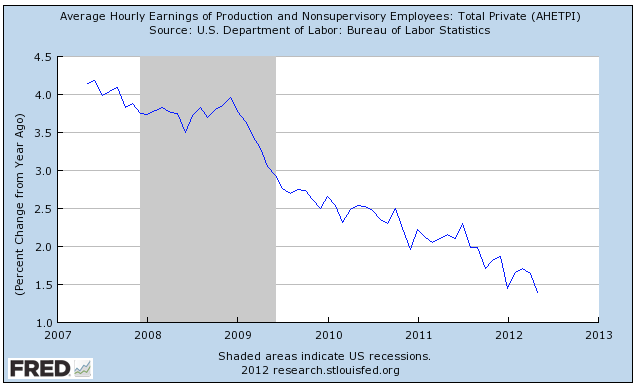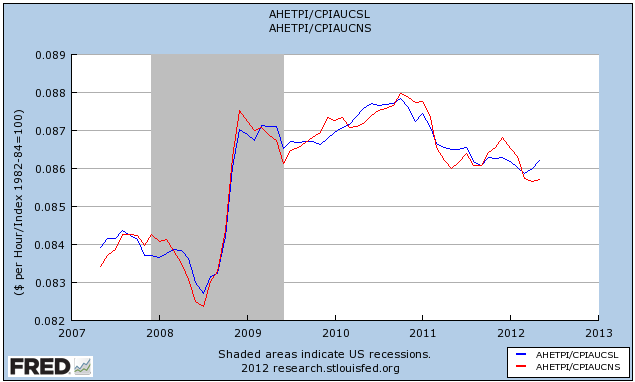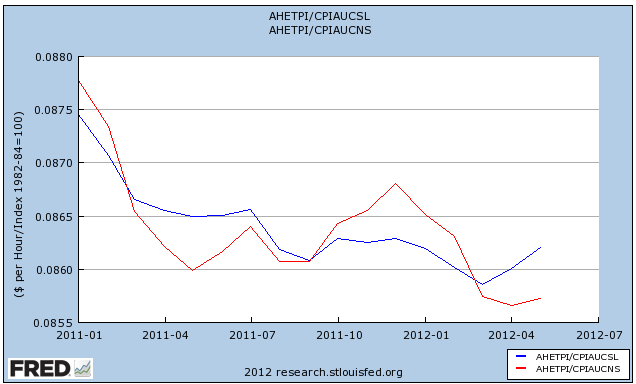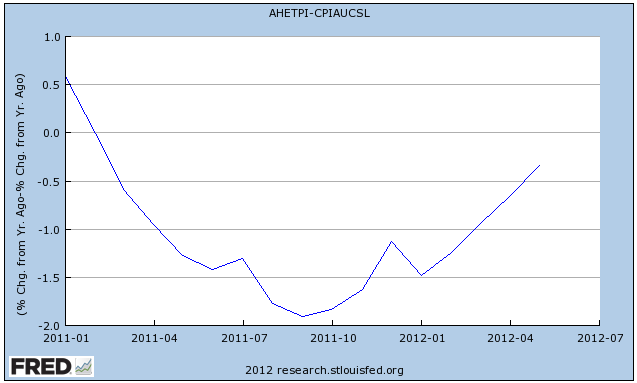- by New Deal democrat
The monthly data released this past week was much better than last week's. Housing permits rose to a new 3+ year high, over 250,000 higher than their all time low in 2009. This boosted the index of Leading Economic Indicators to +0.3. Existing home sales fell slightly. The very erratic Philly Fed index plunged to -16.6 (it is worth remembering that 9 months ago it plummeted below -30 before rebounding).
The high frequency weekly indicators remained generally positive, but the recent comparative weakness in a number of the indicators remains, especially in new jobless claims, so let's start there.
Employment related indicators were mixed:
The Department of Labor reported that Initial jobless claims rose 1,000 to 387,000 last week. The four week average rose another 4250 to 386,250, to the highest level all year. The rise in jobless claims is a serious concern, but there remains some question of whether there is a seasonal adjustment issue or whether something more ominous is going on, as we had a similar rise during the second quarter of 2011. This is a yellow flag for now. If the weakness persists into July, it will become a red flag.
The American Staffing Association Index rose back to 93. It has generally leveled off for the last two months.
The Daily Treasury Statement for the first 15 days of June showed $103.5B vs. $98.8B for the same period in 2011. For the last 20 reporting days, $134.1B was collected vs. $127.6B a year ago, an increase of $6.5B, or +5.1%.
Housing reports were softer than recently, but still positive:
The Mortgage Bankers' Association reported that the seasonally adjusted Purchase Index fell 9% from the week prior (which had been up 12.8%), and was down 2% YoY, still at the upper end of its two year range. The Refinance Index rose 1%. Refinancing is at a 3 year high.
The Federal Reserve Bank's weekly H8 report of real estate loans, which turned positive YoY in March after having been negative for 4 years, this week fell -0.4%, and the YoY comparison declined to +0.5%. On a seasonally adjusted basis, these bottomed in September and remain up +0.9%. The growth rate has weakened in the last few weeks.
YoY weekly median asking house prices from 54 metropolitan areas at Housing Tracker were up + 1.9% from a year ago, the weakest such reading in several months. YoY asking prices have been positive for over 6 months, are higher than at any point last year, and at their maximum seasonal point on a seasonally adjusted basis. Barring the appearance of the long-in-coming foreclosure tsunami (which, per Calculated Risk, may only occur in judicial states and be counterbalanced by the winding down of foreclosures in non-judicial states, which never had any delays), the bottom in prices is here. The Case-Shiller repeat sales index will be reported in the coming week. It remains negative YoY, but has increased on a seasonally adjusted basis for the last two reports in a row.
Same Store Sales were mixed.
Bond prices fell slightly and credit spreads increased again:
Weekly BAA commercial bond rates increased by .02% to 5.05%. Yields on 10 year treasury bonds rose .01% to 1.62%. The credit spread between the two incresed again to 3.43%, a new 52 week high. The recent collapse in government bond yields screams of fear of deflation. An uptick in corporate yields begins to signal increasing fear of default. This pattern frequently occurs on the cusp of a recession.
Rail traffic turned more positive this week.
The American Association of Railroads reported a +0.9% increase in total traffic YoY, or +4,900 cars, at 537.0. Non-intermodal rail carloads were down 2.5% YoY at 287.0. Intermodal traffic was up 5.2% YoY at 250.0. Eight of the 20 carload types were negative YoY vs. 10 types one week ago.
Money supply was positive:
M1 increased +0.9% last week, and also rose +0.6% month over month. Its YoY growth rose to +16.3%, so Real M1 is up 14.6%. YoY. M2 rose +0.6% for the week, and was up 0.3% month/month. Its YoY growth increased to +9.6%, so Real M2 increased to +7.9%. Real money supply indicators continue to be strong positives on a YoY basis, and after slowing earlier this year, are increasing again.
The energy choke collar has almost completely disengaged:
Gasoline prices fell for the ninth straight week, down another .04 to $3.53. Oil prices per barrel fell over $4 to $79.76. Oil hit a new 12 month low on Thursday, and has only been less expensive for about 2 months in the last 3 years. Oil prices are now well below the point where they can be expected to exert a constricting influence on the economy, and gasoline is following. The 4 week average of Gasoline usage, at 8851 M gallons vs. 9321 M a year ago, was off -5.0%. For the week, 8693 M gallons were used vs. 9319 M a year ago, for a decline of -6.7%. This is a serious YoY decline; however, June and early July of 2011 were the only months after March 2011 where there was a YoY increase in usage, so the YoY comparison now is especially difficult. If this decline persists past the middle of July, it will be a red flag.
Turning now to high frequency indicators for the global economy:
The TED spread rose 0.1 to 0.39, in the middle of its recent 4 month range. This index remains slightly below its 2010 peak. The one month LIBOR rose another 0.002 to 0.245. While it has risen slightly above its recent 4 month range, it remains well below its 2010 peak, and has still within its typical background reading of the last 3 years. It is interesting that neither of these two measures of fear have moved significantly despite the chronic Europanic.
The Baltic Dry Index rose 54 from 924 to 978. It remains 308 points above its February 52 week low of 670. The Harpex Shipping Index fell slightly for the third straight week from 451 to 447, but is still up 72 from its February low of 375.
Finally, the JoC ECRI industrial commodities index continued its recent cliff-dive, down from 115.34 to 113.89. This is a new 52 week low. The nearly 15 point collapse in this indicator during the last few months is is the strongest sign of all that the globe taken as a whole is slipping back into recession.
We have severe weakness in commodities. This suggests that Asia as well as Europe is contracting. On the other hand, this ends the profit margin squeeze on US producers, and puts more money in the pockets of US consumers. Global transport is weakening again slightly. Credit spreads continue to widen, which may show a flight to US assets, comparatively greater to Treasuries.
In the US, initial jobless claims are rising. Rail traffic remains mixed. Gallup is showing stalling consumer sales, but is not supported by either ICSC or Johnson Redbook which remain resolutely positive. Gasoline usage is significantly negative YoY again, but this may simply reflect the tougher comparisons with June last year. Bank real estate loans have hit a little soft patch, although mortgage purchases and refinancings are positive. Temporary help is starting to trend sideways. Withholding tax payments and money supply remain positive.
The overall picture is of an incipient global recession, with the US remaining in growth but weakly so for now. I continue to watch consumer spending especially carefully, and in July the picture with gasoline usage and initial claims should become clearer.
Have a nice weekend!
Money supply was positive:
M1 increased +0.9% last week, and also rose +0.6% month over month. Its YoY growth rose to +16.3%, so Real M1 is up 14.6%. YoY. M2 rose +0.6% for the week, and was up 0.3% month/month. Its YoY growth increased to +9.6%, so Real M2 increased to +7.9%. Real money supply indicators continue to be strong positives on a YoY basis, and after slowing earlier this year, are increasing again.
The energy choke collar has almost completely disengaged:
Gasoline prices fell for the ninth straight week, down another .04 to $3.53. Oil prices per barrel fell over $4 to $79.76. Oil hit a new 12 month low on Thursday, and has only been less expensive for about 2 months in the last 3 years. Oil prices are now well below the point where they can be expected to exert a constricting influence on the economy, and gasoline is following. The 4 week average of Gasoline usage, at 8851 M gallons vs. 9321 M a year ago, was off -5.0%. For the week, 8693 M gallons were used vs. 9319 M a year ago, for a decline of -6.7%. This is a serious YoY decline; however, June and early July of 2011 were the only months after March 2011 where there was a YoY increase in usage, so the YoY comparison now is especially difficult. If this decline persists past the middle of July, it will be a red flag.
Turning now to high frequency indicators for the global economy:
The TED spread rose 0.1 to 0.39, in the middle of its recent 4 month range. This index remains slightly below its 2010 peak. The one month LIBOR rose another 0.002 to 0.245. While it has risen slightly above its recent 4 month range, it remains well below its 2010 peak, and has still within its typical background reading of the last 3 years. It is interesting that neither of these two measures of fear have moved significantly despite the chronic Europanic.
The Baltic Dry Index rose 54 from 924 to 978. It remains 308 points above its February 52 week low of 670. The Harpex Shipping Index fell slightly for the third straight week from 451 to 447, but is still up 72 from its February low of 375.
Finally, the JoC ECRI industrial commodities index continued its recent cliff-dive, down from 115.34 to 113.89. This is a new 52 week low. The nearly 15 point collapse in this indicator during the last few months is is the strongest sign of all that the globe taken as a whole is slipping back into recession.
We have severe weakness in commodities. This suggests that Asia as well as Europe is contracting. On the other hand, this ends the profit margin squeeze on US producers, and puts more money in the pockets of US consumers. Global transport is weakening again slightly. Credit spreads continue to widen, which may show a flight to US assets, comparatively greater to Treasuries.
In the US, initial jobless claims are rising. Rail traffic remains mixed. Gallup is showing stalling consumer sales, but is not supported by either ICSC or Johnson Redbook which remain resolutely positive. Gasoline usage is significantly negative YoY again, but this may simply reflect the tougher comparisons with June last year. Bank real estate loans have hit a little soft patch, although mortgage purchases and refinancings are positive. Temporary help is starting to trend sideways. Withholding tax payments and money supply remain positive.
The overall picture is of an incipient global recession, with the US remaining in growth but weakly so for now. I continue to watch consumer spending especially carefully, and in July the picture with gasoline usage and initial claims should become clearer.
Have a nice weekend!

















































